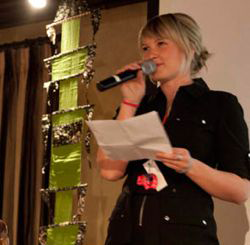
Presentation speech by Andrea Wettstein at Taste the World Calgary April 24, 2013.
After years of hearing countless stories from my parents and John and Nina about the work being done in Southeast Asia, I was keen to witness things for myself. Last winter, I was able to take an extended vacation from work to visit Burma and Cambodia.
This was by far the most amazing experience of my life. It’s hard to know where to begin to really describe it, but I think what really stuck with me was the positive, resilient nature of the people there, and their ability to be resourceful with what they have.
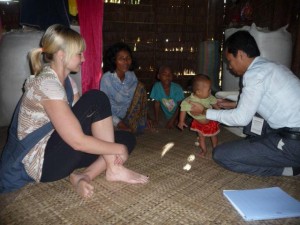 The first place I visited in Burma was a malaria and HIV clinic in a village outside of Yangon. It was there I met Dr. Frank and Dr Nini. It was early morning when we arrived, but already there were close to 50 people waiting on re-purposed church pews to see the Doctors. As we all know, HIV is a major issue in SE Asia. This clinic was taking a preventative approach to HIV – they were testing pregnant mothers, educating them, and providing support. I appreciated the sensitive nature these doctors took in dealing with HIV patients. They allowed them privacy when visiting the clinic, facilitated support groups, and connected them with a psychologist in order to deal with mental aspects of being HIV positive. To me, this level of support and education was incredible. It was obvious what a massive effect this clinic was having on the local people, and their future.
The first place I visited in Burma was a malaria and HIV clinic in a village outside of Yangon. It was there I met Dr. Frank and Dr Nini. It was early morning when we arrived, but already there were close to 50 people waiting on re-purposed church pews to see the Doctors. As we all know, HIV is a major issue in SE Asia. This clinic was taking a preventative approach to HIV – they were testing pregnant mothers, educating them, and providing support. I appreciated the sensitive nature these doctors took in dealing with HIV patients. They allowed them privacy when visiting the clinic, facilitated support groups, and connected them with a psychologist in order to deal with mental aspects of being HIV positive. To me, this level of support and education was incredible. It was obvious what a massive effect this clinic was having on the local people, and their future.
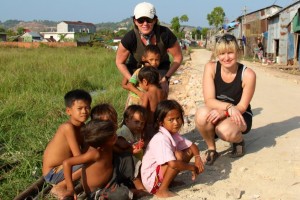 From Yangon, I travelled to Siem Reap, where I volunteered at the Angkor Hospital for Children. Though Angkor Wat is considered Siem Reap’s main attraction, the Angkor Hospital for Children is its heart & soul. The number of children and families this hospital helps is astounding.
From Yangon, I travelled to Siem Reap, where I volunteered at the Angkor Hospital for Children. Though Angkor Wat is considered Siem Reap’s main attraction, the Angkor Hospital for Children is its heart & soul. The number of children and families this hospital helps is astounding.
I have so many stories to share from AHC, but I’ll choose one. We had the opportunity to visit the hospital late one night, around 11 pm. The grounds – once crowded with children and families waiting for the doctors – were now covered in tarps. There must have been at least 100. Underneath each tarp, was a sleeping family – children, parents, uncles, aunts – all fast asleep under the open sky, awaiting the next morning where they could line up to see a doctor. It struck me then how far these families had journeyed to seek medical help, and how little they had. It also struck me that although there were hundreds of people here, the grounds were silent.
Inside the hospital was a different story. Although it was nighttime, the doctors were bustling and busy. We entered the ICU, where there were four people – one Cambodian doctor, a doctor in training and three Cambodian nurses – intently examining a premature baby. These staff were completely engaged in their job, surrounded in the ICU by the tiny lives they were closely monitoring, and ultimately saving. I learned at that point that while AHC provides healthcare to poverty stricken Cambodian children, it also provides education and career opportunities to countless Cambodian people.
I could go on and on about the education AHC provides, the garden that single handedly nourishes the hospital, cooking classes that teach parents how to keep their babies nourished, the before and after photos of children who enter AHC malnourished and leave healthy, the satellite hospital that helps families in hundreds of surrounding villages, the trips I accompanied AHC staff on, to follow up with former patients … I think it’s important to say that through this trip I learned first-hand, that contributions to MAM or AHC directly impact people. A contribution will save lives. It will provide parents the education to save the lives of their children, and it will give a Cambodian doctor or nurse a career, so they can save hundreds of future lives.
6º Andrea Wettstein
Composer & Voice Director

Corinne and Brad Jefferson, along with their children and a friend, visited Angkor Hospital for Children in the fall of 2013.
My experience of the Angkor Children’s Satellite Hospital in Siem Reap was inspiring. In all my dreams I never thought I would go to a place where miracles are created. The hospital changed my mind on how I see the world today. All it takes is a few steps in making that journey. Once you have experienced it you will see the star in each child and doctor. A smile is all you need in return for going up to a child and giving them a toy. I knew at that moment the experience would impact me forever. If I had not visited the hospital I would never have thought of all the possibilities that make a difference if we stand together. All you have to do is take that first step. I promise you, take that first step and the rest will surprise you and you will be filled with greatness.
– Lauren Jefferson
Grade 12 High School Student
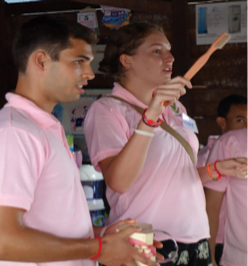 Alexis Paquet and Kendre Jefferson are giving a demonstration on effective oral hygiene and brushing technique which was translated by Samnang. Oral hygiene is one of the most challenging areas of health promotion. Donations of toothbrushes, toothpaste and soap were given to all.
Alexis Paquet and Kendre Jefferson are giving a demonstration on effective oral hygiene and brushing technique which was translated by Samnang. Oral hygiene is one of the most challenging areas of health promotion. Donations of toothbrushes, toothpaste and soap were given to all.
By visiting the hospital, we wanted to show these families our commitment support and dedication. It showed us that we can play an active role to bring happiness to the lives of these children and their future. We were fortunate to see the biggest smiles from these people that have so little access to things we take for granted. Everyone was welcoming, and seemed receptive to what we had to say. We felt we were well received which we were also thankful for. Also, the Satellite team made us feel proud and felt like we can make a difference. We felt very privileged that we were invited by them and embraced the whole experience. There is no better feeling than helping others. It has left us with memories that will last a lifetime of bringing hope and making the world a better place.
– Kendre Jefferson, Kara Jefferson and Alexis Paquet
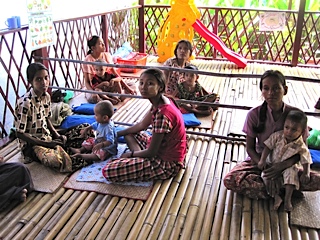
In November 2012, my husband and I went to Myanmar on a biking tour. Myanmar is a beautiful country with an ancient culture struggling to find its footing in a modern world that has largely left it behind. As is the case with most guided tours everywhere, our trip to Myanmar paraded us by wonderful monuments, temples and comfortable tourist facilities. While this was all fascinating, the most memorable part of our trip was not on the tour company’s itinerary.
We are both physicians and have worked as volunteers in developing countries over the years. Before picking up our bicycles in Yangon, we spent a day checking out MAM (Medical Action Myanmar) an NGO that supports a number of clinics that bring health services to the poorest people in Myanmar. Dr. Ni Ni Tun, a Myanmar physician, kindly spent a morning explaining MAM’s activities and showing us one of their clinics in a poor suburb of the capitol. Having had some experience in the difficulties and challenges inherent in providing health care in developing countries, we were very impressed by the dedication, thoroughness and vision of this Dutch based organization.
For anyone looking to make a donation to a project that is making a difference you cannot do any better than contributing to MAM.
– Dr. Linda Harth and Dr. Peter Nash (husband and wife)
Vancouver based Doctors
Donna Ramsden is an operating room nurse at Vancouver General Hospital. In 2008 with the help of CW Asia Fund, she was able to visit a remote heal care program in Myanmar run by the Metta Development Foundation. This is her report back.
The Kachin people have very limited access to medical care, both due to the lack of facilities & the extreme poverty of the people. There is a government hospital in Myitkynia, the capital of Kachin State, to provide medical care to the surrounding area but there is no provisions for the people living in the country side.
The Metta project involved providing workshops on First Aid, basic nursing and neonatal care to young men and women who would travel into the surrounding areas to deliver health care people in the remotest villages. Metta funded the backpacks filled with medical supplies, the salaries for the two nurse instructors and for the participants.
I was very impressed with the enthusiasm of the participants, their sense of humour and with the questions they asked. Initially quite shy, they quickly opened up as we discussed issues such as basic hygiene and wound care. I had arrived armed with the text, “Where There Is No Doctor”, in English and Kachin and attempted to answer their questions with the aid of the intrepretor.
The two retired nurse instructors had travelled several days on foot to deliver the workshops and the supplies. They would return within a month to meet again with the participants to replenish supplies and to discuss any problems.
I can only imagine the relief the villagers must feel on seeing these young people arrive in their village
– Donna Ramsden
